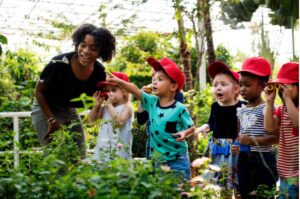
By Sarah Arnold and Alex Schuh
It’s easy to get wrapped up in the daily logistics of running an afterschool program, with many people, materials and schedules to keep track of. Those details can be so all-encompassing that it is easy to lose sight of the main goal—making sure that all activities we offer have obvious educational value to our students. We should be able to answer YES! to questions like these: Are my students gaining new skills and content with this activity? Does this activity excite my students about learning? If the answer is… “Maybe?” Or “I’m not really sure”, we suggest a few ways to dive in and make sure that your activities are clearly hitting the mark that makes 21st C CLC such a great program.
1. The best programs start with high-quality curricular materials.
High quality 21st C CLC activities are often based on high quality curricular materials- sometimes the same materials used by the students in their classrooms during the school day (for example, Eureka Math) and sometimes materials students use only outside of the regular school program (for example, Lego Mindstorms). Curriculum materials could also come from national such as National History Day, MathCounts, National Science Fair, and Future City. Most importantly, the materials must be well organized, easy to use (and store), age/grade-appropriate and clearly linked to standards of knowledge and skills that the students need to work on. 21st CCLC programs have a special opportunity to give students more say in pursuing projects and questions that are more meaningful to them than much of the work they do during the school day, so look for curricula that include projects with opportunities for student self-direction and collaborative work. Other examples of high-quality STEM curricula that have been developed with 21st C programs in mind include: NASA, NPS (National Park Service) and NOAA (National Oceanic and Atmospheric Administration).
2. Make it all about the students who come to you
Students come to afterschool programs for all types of reasons, including needing to make up for deficits in skills and knowledge compared to their instructional levels, needing a safe place to be after school, needing socializing time with friends, and many more. This means that the students you see in your programs could have special education needs, be advanced for their grade levels, have extraordinary social and emotional needs, and combinations of those needs. We have seen afterschool and summer programs that have students with widely varying needs and interests, all in the same small classrooms. The afterschool and summer learning times provide opportunities to tailor program to student needs, provided that those needs are well understood and that there is ample staff available to tailor experiences to those needs. In order to meet the needs of all students, we suggest doing the following: (1) Ensure strong channels of communication between program teachers and school day teachers about each student, and with parents, if possible, (2) Provide a variety of programming that can be accessed at multiple levels in the same classroom, such as with project based learning or multi-leveled reading materials (e.g., Lego Robotics, 100 Book Challenge), (3) Give students input into the direction of their activities, as appropriate for their ages, and (4) Provide enough staff members, through aids and tutors as necessary, to enable personal attention and small group work (a program like Play on Philly is a good example of how that can work). A full review of your curriculum and program offerings should be conducted at least once a year to ensure that your program is meeting your students where they are academically and supporting their needs for social and emotional development.
3. Develop student leadership– and followership
 It has been said that the best followers make the best leaders. Our country needs great leadership to ensure that we have a strong democracy that will endure the many challenges we will face in the future. With their built-in flexibility of structure and programming opportunities, afterschool and summer programs provide ideal environments for children to learn how to collaborate, learn how to structure and lead projects, and learn how to follow instructions to contribute to projects. In addition to giving students opportunities to practice leadership, teamwork, and followership in individual projects and activities, you can involve students in the design of the program overall, which will encourage students to take the lead in initiating program ideas and developing agendas and plans and improve their involvement and investment in the program. This type of leadership practice can be incorporated in a wide variety of activities, such as recreational sports, academic competitions, and games. The role-playing game Dungeons and Dragons, for example, or student-designed and led showcases, are great older-grade activities because of the inherent challenges and skill development in creativity, teamwork, planning and even language use. The leadership components of programs can and should be connected to state standards, where possible, such as to the Pennsylvania Career Education and Work Academic Standards.
It has been said that the best followers make the best leaders. Our country needs great leadership to ensure that we have a strong democracy that will endure the many challenges we will face in the future. With their built-in flexibility of structure and programming opportunities, afterschool and summer programs provide ideal environments for children to learn how to collaborate, learn how to structure and lead projects, and learn how to follow instructions to contribute to projects. In addition to giving students opportunities to practice leadership, teamwork, and followership in individual projects and activities, you can involve students in the design of the program overall, which will encourage students to take the lead in initiating program ideas and developing agendas and plans and improve their involvement and investment in the program. This type of leadership practice can be incorporated in a wide variety of activities, such as recreational sports, academic competitions, and games. The role-playing game Dungeons and Dragons, for example, or student-designed and led showcases, are great older-grade activities because of the inherent challenges and skill development in creativity, teamwork, planning and even language use. The leadership components of programs can and should be connected to state standards, where possible, such as to the Pennsylvania Career Education and Work Academic Standards.
4. Diverse, skilled staff members keep students coming back
The strength of every program is its skilled, dedicated staff. Children in afterschool and summer programs are looking to have fun learning while building and making new friendships. They are also looking to spend time with adults who can help them to feel good about themselves and give them a window into a better understanding of their complex world. Many 21st CCLC programs do a good job of recruiting highly qualified, certified teachers to work with the students, but there are many other adults who can bring other, equally valuable perspectives to the students as well. Of course your staff should be knowledgeable and experienced in the subject they’ll be teaching/mentoring. These staff members could come from many different places, though. We’ve seen many successful programs that were staffed with: (1) retirement-age reading tutors, (2) business mentors, (3) karate instructors, (4) college students, (5) professional musicians, and more. Most importantly, the children in your program see the adults as part of their long-term support system, as mentors and guides on their journey. So, it is essential to have staff members who will attend consistently and reliably—they must be people the students can depend on to be there for them. Big Brothers/Big Sisters has a good list of the qualities that make a great mentor.
Our decades-long experience in planning, observing and evaluating dozens of 21st Century CLC programs has provided us with the above insights into what makes a high quality program that produces great results for kids and schools. Four essential ingredients go into the recipe for a great program: (A) High quality curricular materials; (B) Diverse offerings that match participating students’ needs; (C) Ample opportunities for students to develop leadership and teamwork skills; and (D) Skilled staff members who are committed to serving as mentors to a variety of students. With these components in place, we are certain that your program will truly shine and become a beacon and a point of pride for your students and families.
We welcome your feedback on the subject of what makes a great 21st C CLC program and what types of resources have worked best for you and your students. What have you included in your program that got your students most excited to be there? What have you done with your program that has been particularly successful in helping students learn and/or bringing them back to participate over the long term? What kinds of obstacles have you experienced when trying to maintain or build a high quality program? Please leave your comments below.
